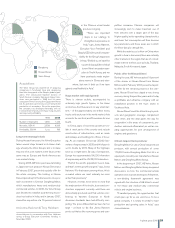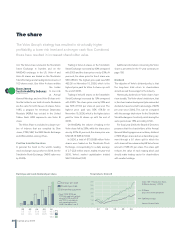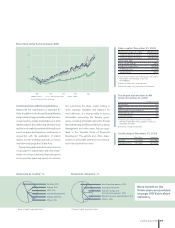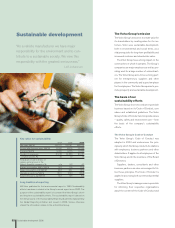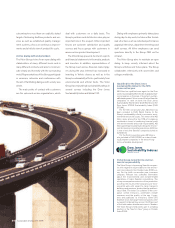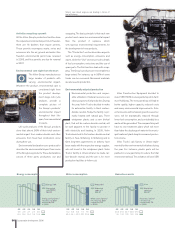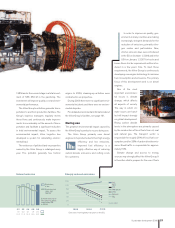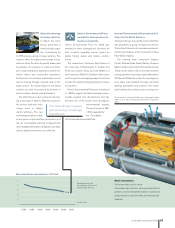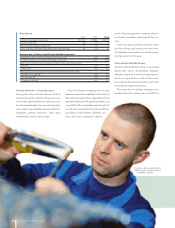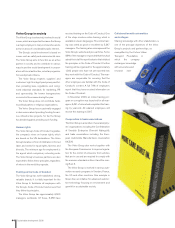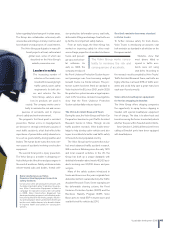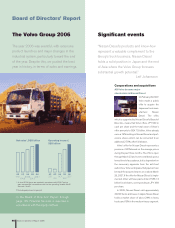Volvo 2006 Annual Report Download - page 40
Download and view the complete annual report
Please find page 40 of the 2006 Volvo annual report below. You can navigate through the pages in the report by either clicking on the pages listed below, or by using the keyword search tool below to find specific information within the annual report.
Activities requiring a permit
All the Volvo Group’s production facilities have
the requisite envir onmental permits. In Sweden,
there are 16 facilities that require permits.
These permits encompass waste, noise and
emissions into the air, ground and water. One
Swedish environmental permit was renewed
in 2006, and four permits are due for renewal
in 2007.
Environmental care right from the start
The Volvo Group manufactures a
large number of products with
varying environmental impact.
Whatever the product, environmental care is
considered right from
the product develop-
ment stage. Life cycle
analyses provide a
complete picture of
the Group’s products’
environmental impact
throughout their life-
span, from raw material
to waste.
Life cycle analyses of the Group’s products
show that almost 90% of their total environ-
mental impact from carbon-dioxide and other
emissions from fossil fuel combustion occur
during their use.
Environmental declarations are produced to
describe the environmental impact from some
of the Group’s key products. These declar ations
consist of three parts: production, use and
Volvo Construction Equipment decided to
invest SEK 150 M in a new paintshop at its facil-
ity in Hallsberg. The new paintshop will lead to
better quality, higher capacity, reduced costs
and many environmental improvements. Solv-
ent emissions will be halved, greenhouse emis-
sions will be dramatically reduced through
lower fuel consumption, and considerably less
waste will be generated. The new paintshop will
have its own treatment plant, which will more
than halve the discharge of water to the munic-
ipal treatment plant despite increased produc-
tion volume.
Volvo Trucks’ cab factory in Umeå imple-
mented further environmental initiatives during
the year. For instance, plastic parts will be
painted in a new paintshop to reduce the total
environmental load. This initiative will cost SEK
scrapping. The basic principle is that each new
product must cause less environmental impact
than the product it replaces, which
sets rigorous environmental requirements for
the development of new products.
The “Production” section describes aspects
such as energy consumption, emissions and
waste, while the “Use” section provides details
of fuel consumption, emissions and the use of
spare parts. The third section deals with scrap-
ping. The Group’s products are recoverable to a
large extent. For instance, up to 95% of some
trucks can be recovered. Recovered materials
are also used in production.
Environmentally adapted production
Environmental protection and respon-
sible utilization of natural resources are
obvious aspects of all production. During
the year, Volvo Trucks decided to make
its automotive facility in Gent carbon-
dioxide neutral. Today, the facility is pri-
marily heated with natural gas. Three
windpower plants and a new biofuel
plant, that will be carbon-dioxide neutral, will
be built adjacent to the facility to provide it
with electricity and heating. In 2005, Volvo
Trucks launched its first carbon-dioxide neutral
facility in Tuve, Göteborg. In Göteborg and in
Gent long-term agreements on delivery have
been made with the respective energy supplier,
who will invest in the windpower plant. Volvo
Trucks’ facility in Umeå will also be made car-
bon-dioxide neutral, and the aim is for more
production facilities to follow suit.
Hazardous wasteWater consumption
2.7
05
2.6
06
2.6
03
2.6
Energy, TWh
Energy/net
sales MWh/
SEK M
Energy consumption/
net sales has been
reduced by 9%
in 2006.
02
2.7
11. 6 10.514.914.5 13.4
04
7.4
05
7.6
06
8.6
03
9.2
Water, Mm3
Water/net
sales m3/
SEK M
Water consumption/
net sales has been
reduced by 5%
in 2006.
02
8.5
32.1 30.649.152.0 42.2
04
23.6
05
27.0
06
21.6
03
20.5
k ton
Waste/net
sales kg/
SEK M
Hazardous waste/
net sales has
increased by 7%
in 2006.
02
24.7
102 109124116 123
04
Volvo’s new diesel engines are leading in terms of
fuel efficiency.
Energy consumption
36 Sustainable development 2006





